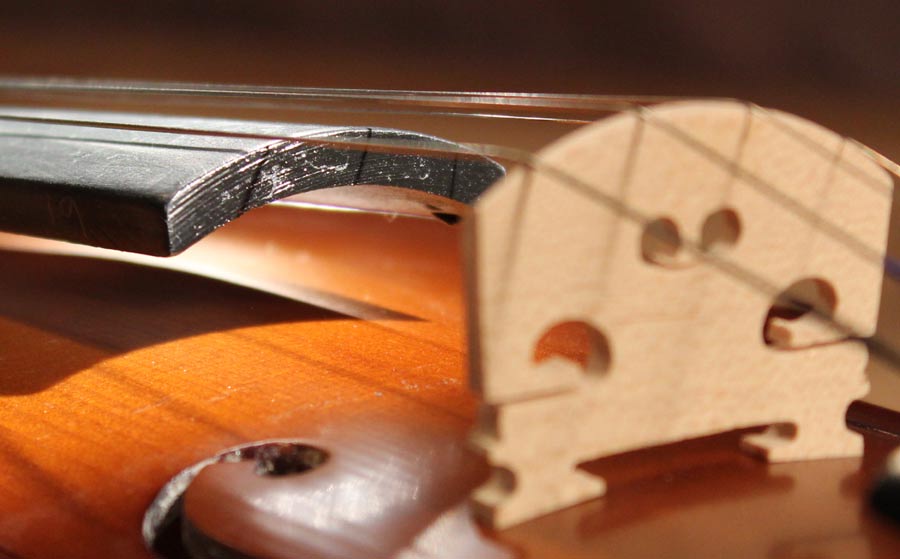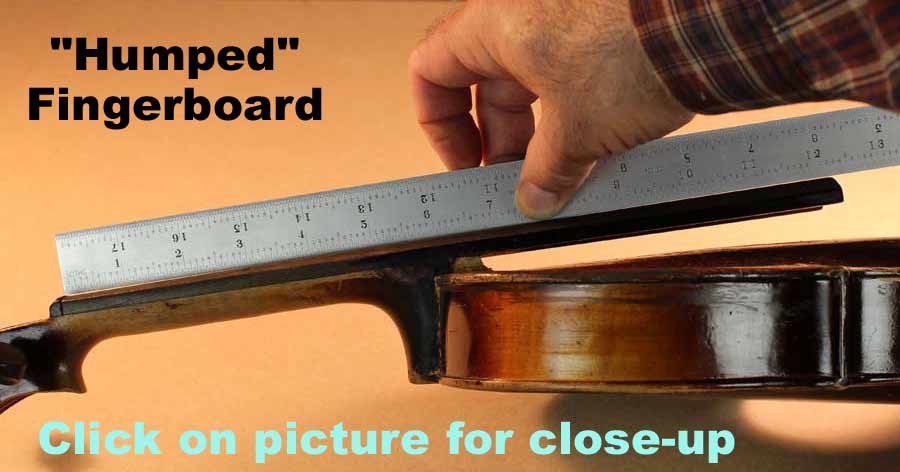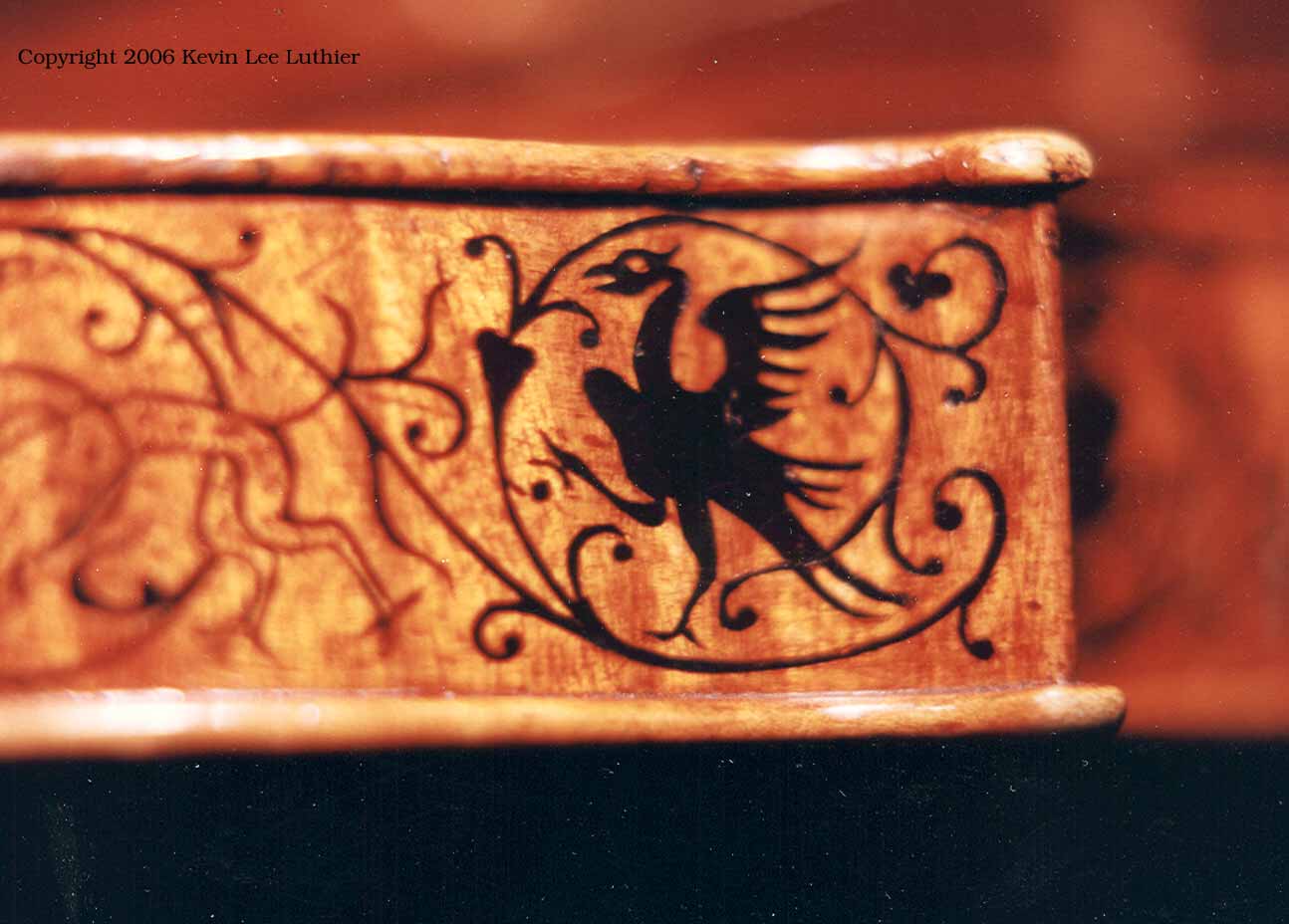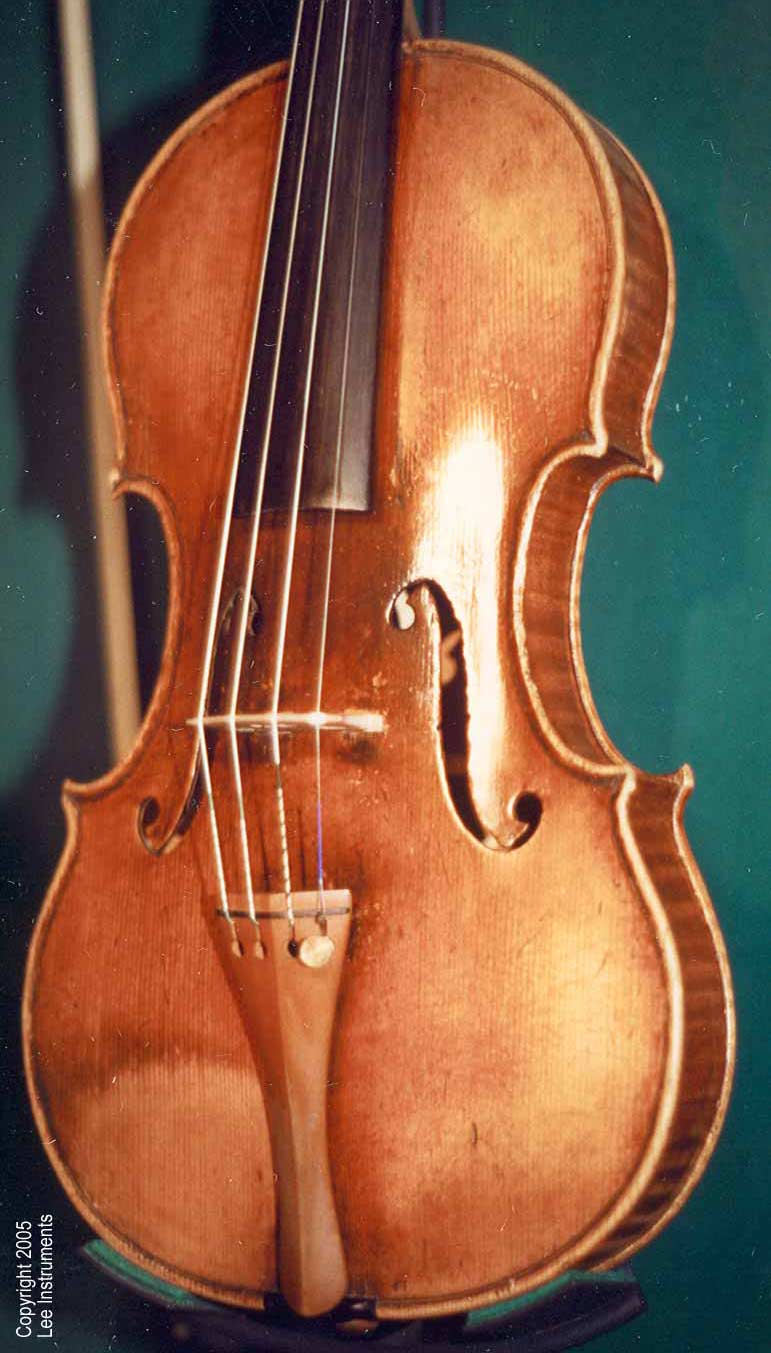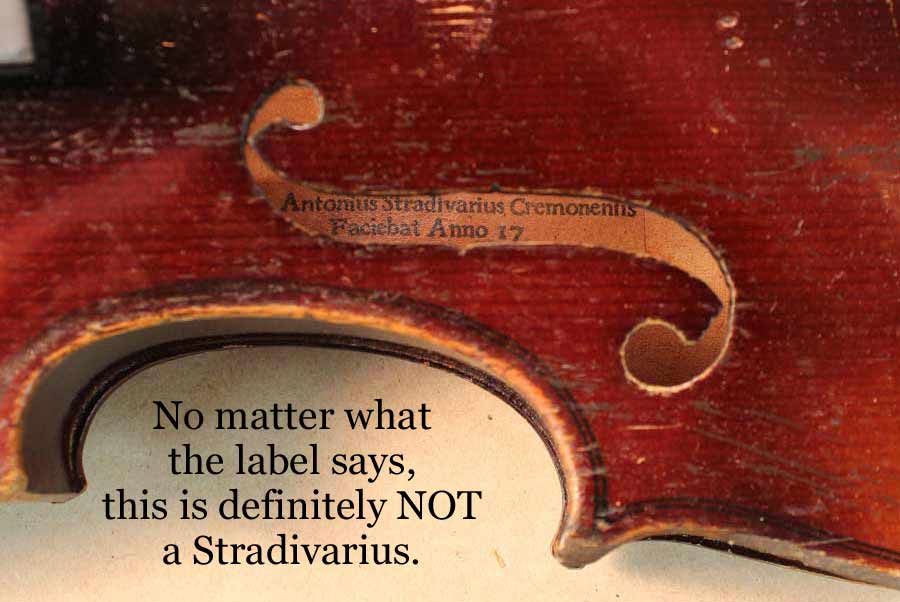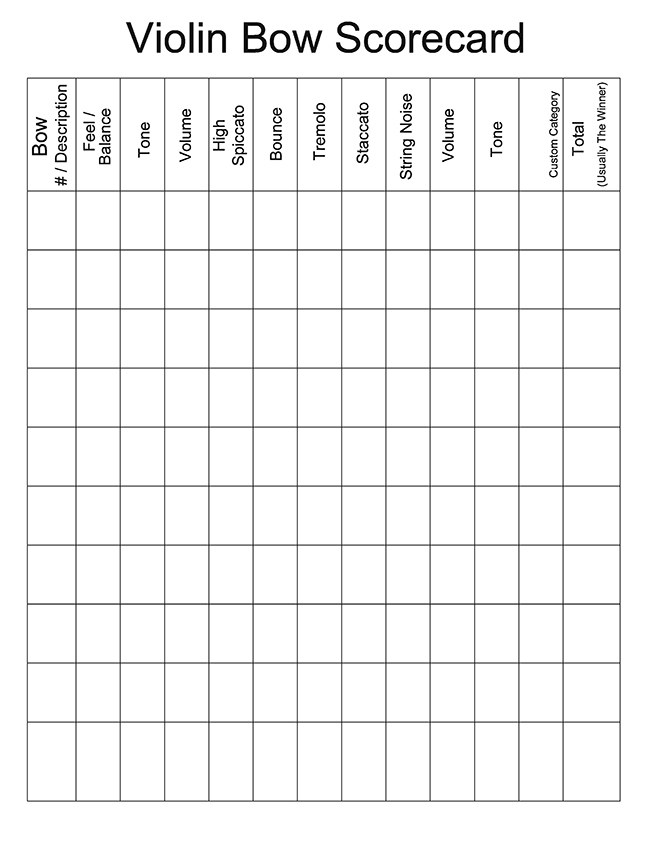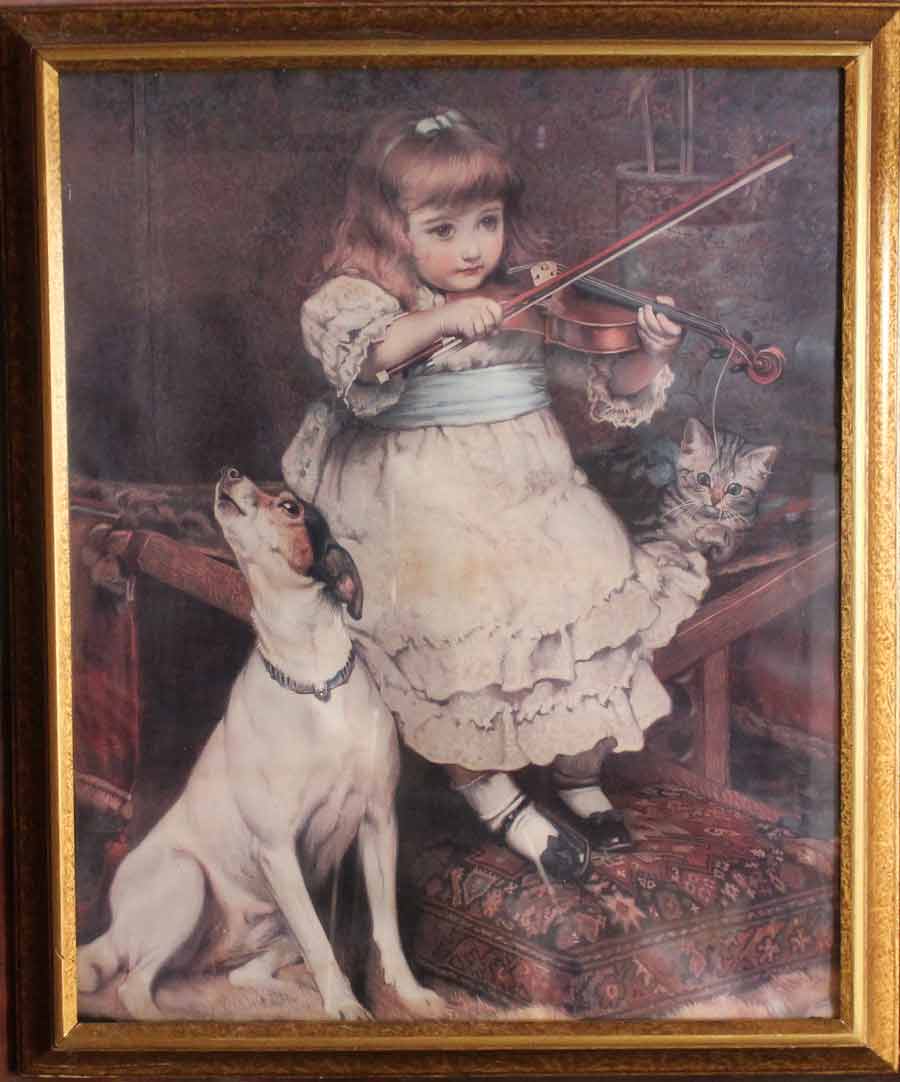
Robert Braine, July 1908 “Next to choosing a wife or buying a good horse, I believe life has few more difficult problems than getting hold of a thoroughly satisfactory violin.
Take a dozen violins, each made by the same maker from identical wood, yet each of these violins will be different, each will posses a soul of its own.
It is not to be denied that good violins are occasionally picked up in pawn shops, second hand stores, etc., but it requires expert knowledge, and to find a real Cremona is as rare as winning the capital prize in a lottery.
These violins often have warped fingerboards, old bridges not properly fitted, crude sound posts, loose base bars, badly fitting pegs and open cracks. Repairing violins is expensive and the chances are that the instrument will cost more in the end than if bought in first class order from a good music house.”
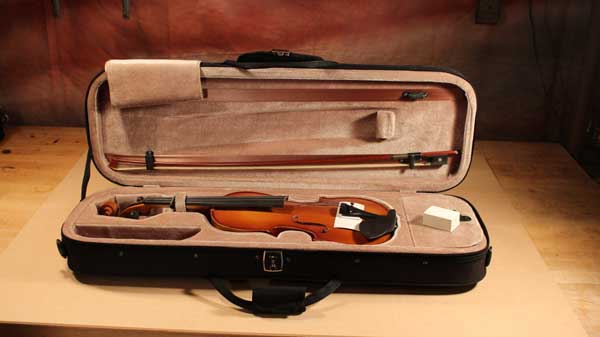
What you might expect for $34.95 off ebay. Good for the price; but not very good.
Painted fingerboard and cheap bridge. Click for closeup of fingerboard.
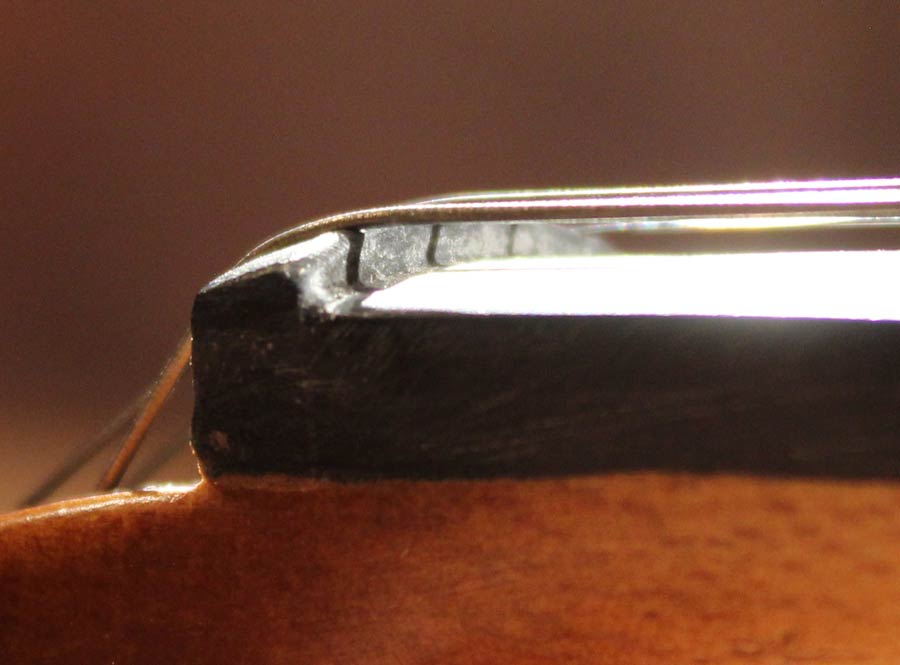
Nut (string height) is usually WAY too high on cheap instruments such as this; making playing a chore for anyone.
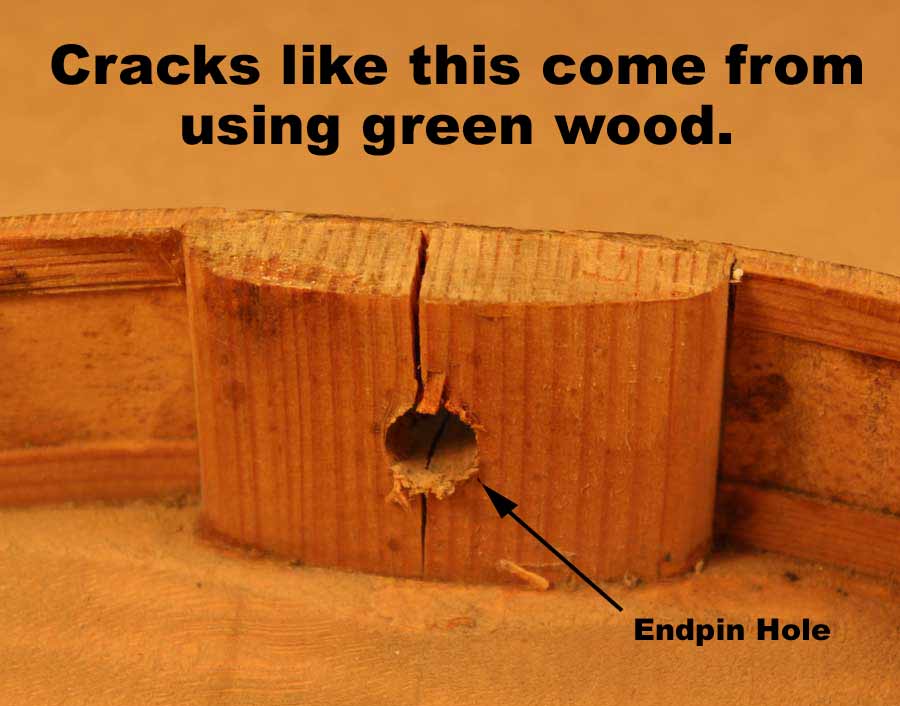
You won't know if a new violin is made from green wood until it's a few years old, when it starts cracking and falling apart. Especially in dry climates.
Cellos, on the other hand can develop huge cracks very quickly in a dry climate.
Cello dealers in dry areas will actually “pop” the upper and lower bout seams, let them dry for a month or two, then glue them back together on mid-level instruments made from green wood.
A humped fingerboard is one of the most common problems on cheap instruments, and one of the most “miserable” things to live with as a player.
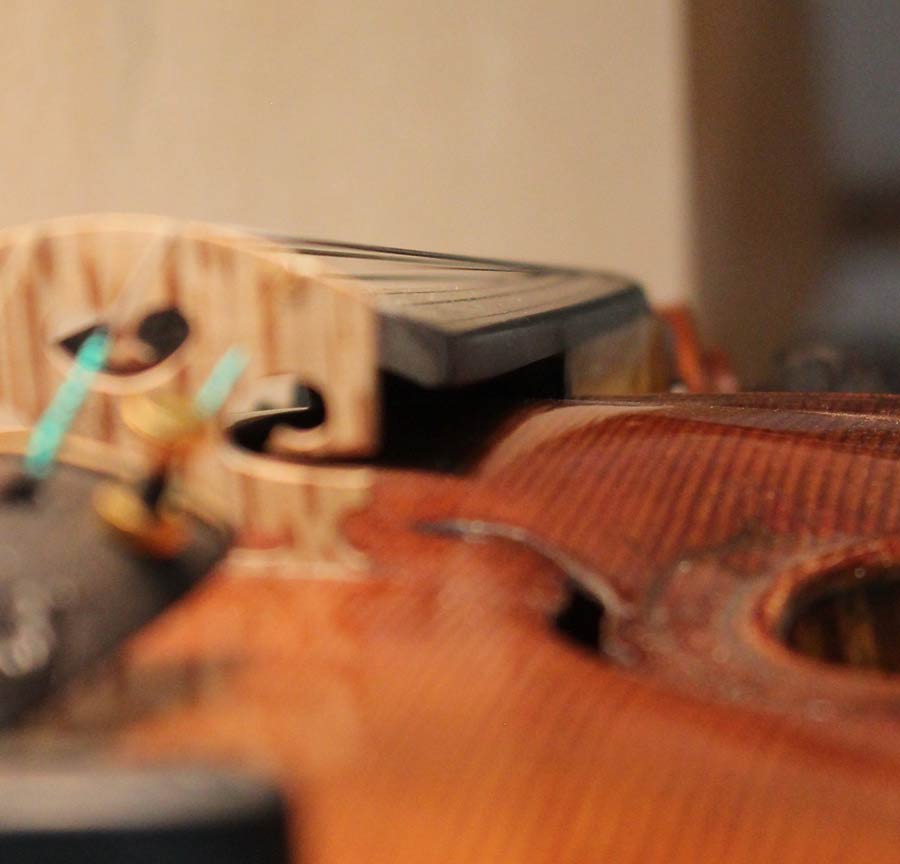
A
properly scooped fingerboard under the E-string, and below, under
the G-string.
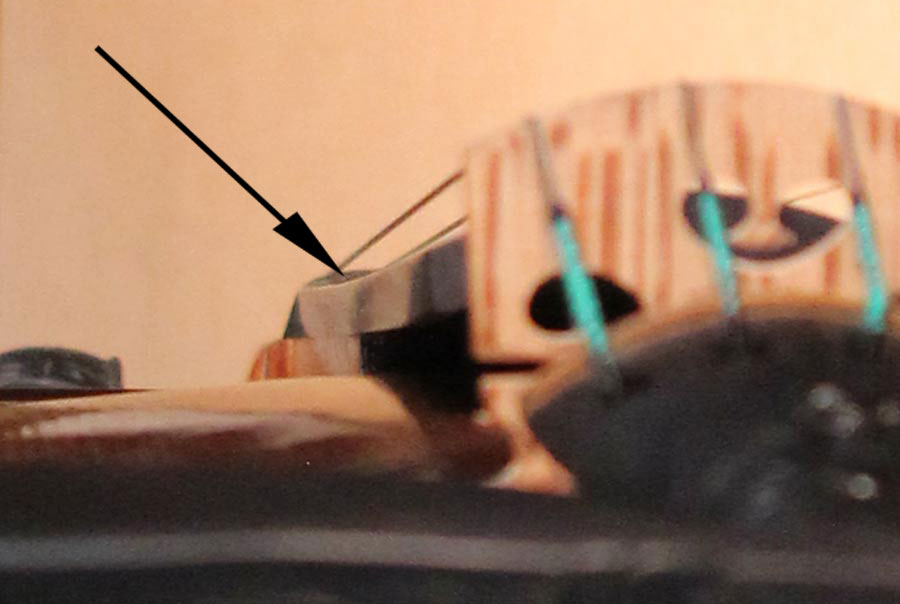
Regardless
of how much you pay for your instrument, if you don't want to
suffer from a G-string that buzzes, make sure that it has enough
scoop in the fingerboard.
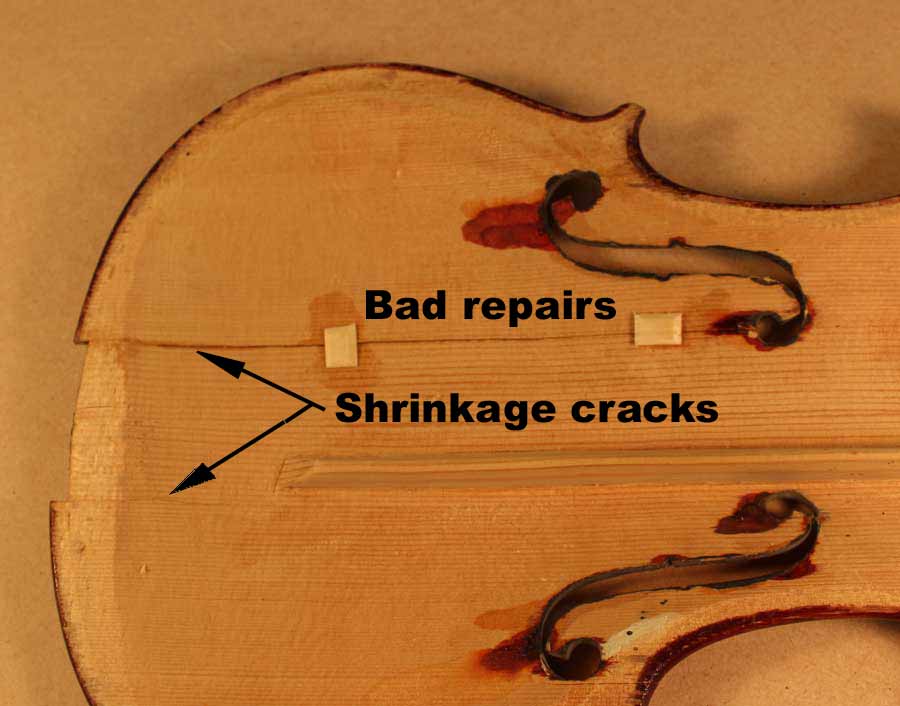
Most dealers have special lights and mirrors that allow them to look inside the instruments and see most repairs (and the work to be done) without hurting the instruments or taking them apart.
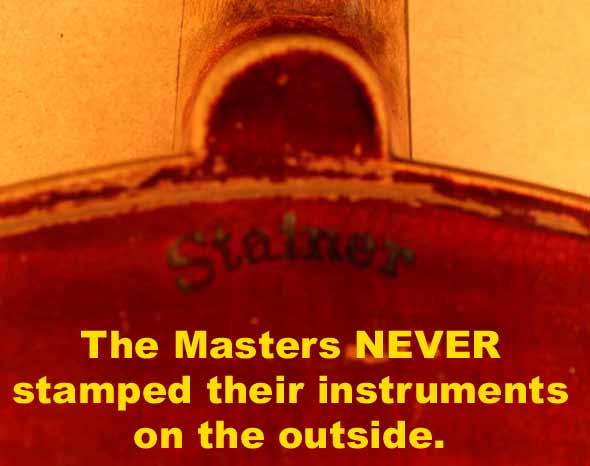
They also NEVER stamped “Conservatory” etc., or anything else on their scrolls.
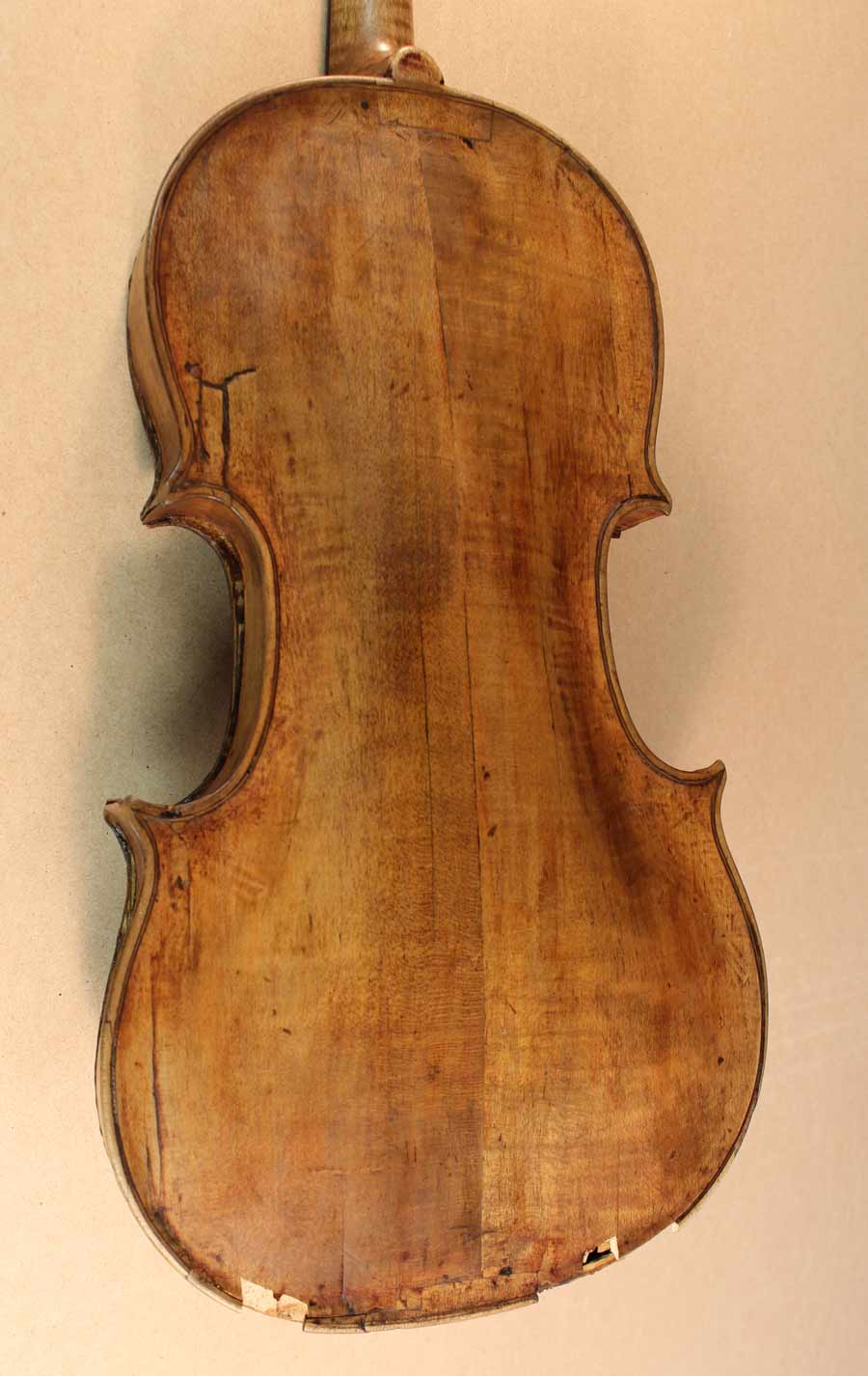
This
violin is very old, and has a lot of character, but most musicians
should leave instruments like this alone. (At least until they
have been fully repaired and restored by a reputable dealer.) But
even then; if there is any way that you can afford an instrument
that has not had massive repairs, it's always worth the extra
money.
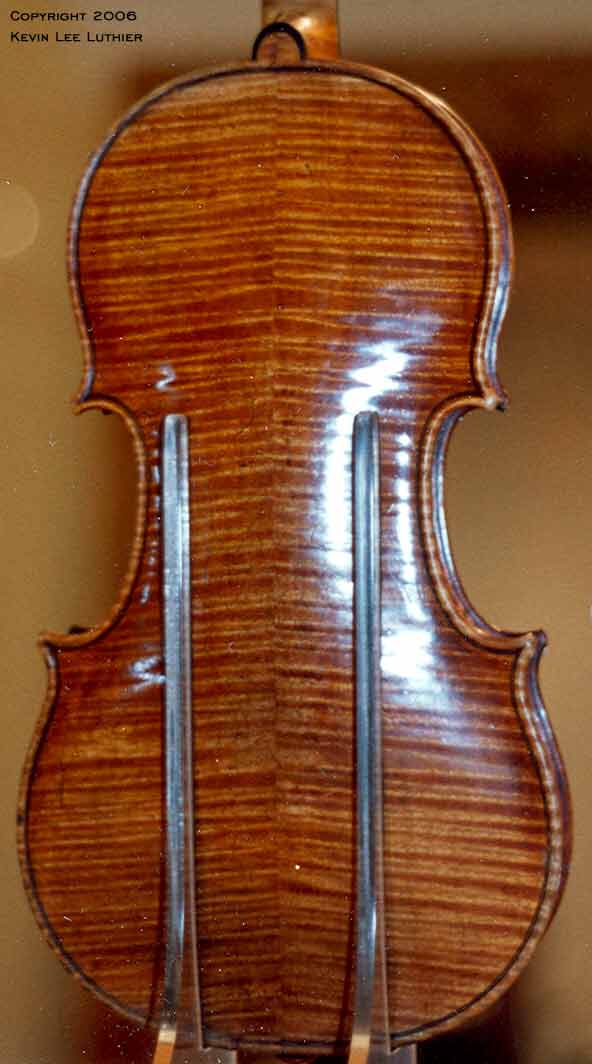
The back and left c-bout of “The Harrison” by Antonio Stradivari 1693 Possibly the finest “Long Pattern” Stradivarius in existence. This is a good example of what the varnish looks like when investing 1.5 million dollars or more.
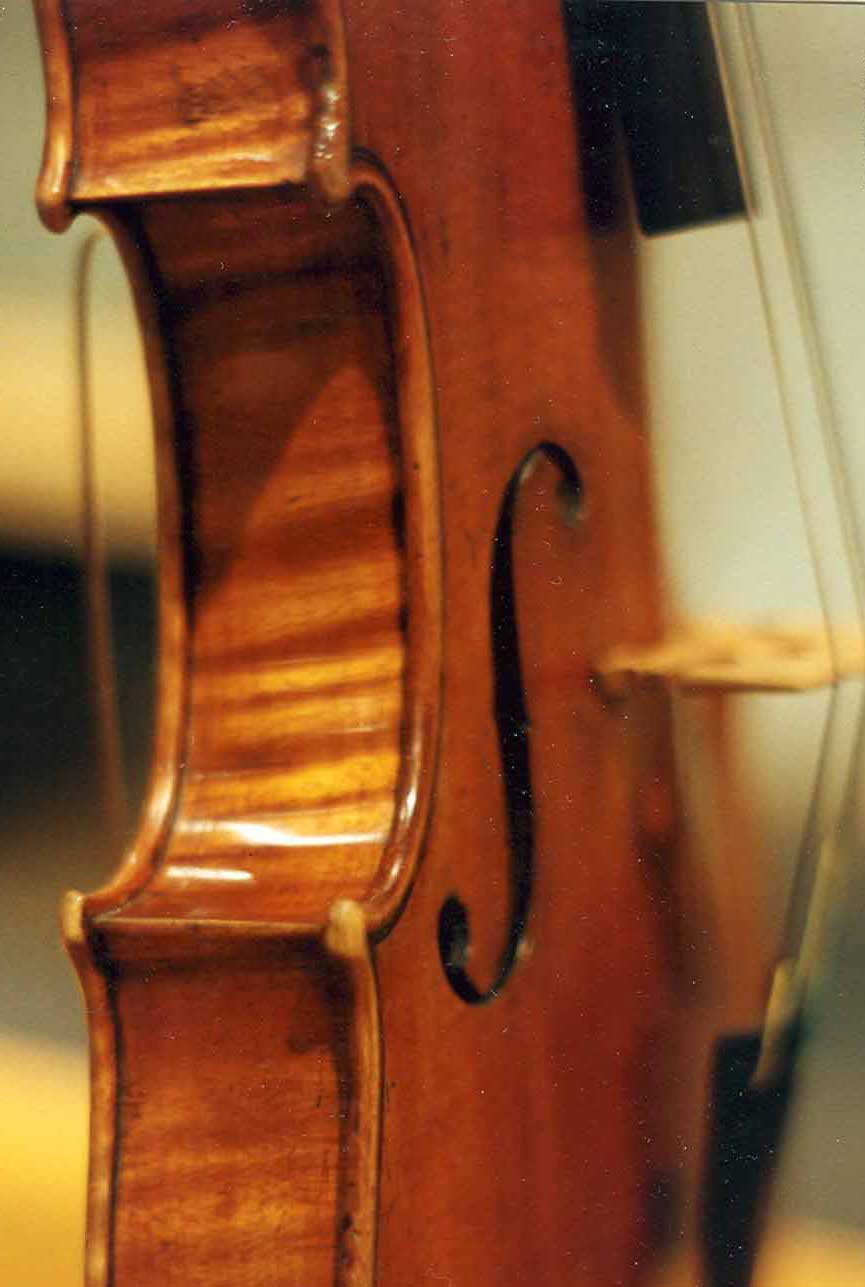
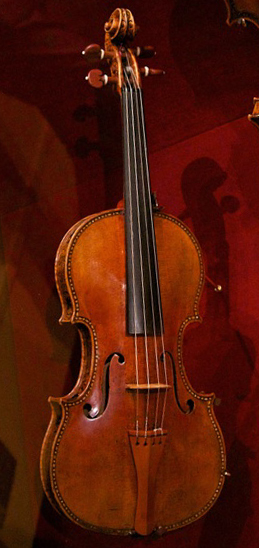
And
for few million more, you may consider a fine inlaid Stradivari,
like “The Greffuhle” 1709
Though consider this:
When I first picked up the Greffuhle, the sound was a complete disappointment. But who can blame it; it had a gut E-string, a steel A string, a Dominant D and a G-string that was old and unrecognizable. But after I adjusted the soundpost to where it should be and replaced all the strings, it instantly came to life and became the dream that it truly is.
You can't judge any instrument's true value unless it is set up properly.
“Il Cannone”
The most valuable musical instrument in the world.
Click on the picture for more images than anywhere else in the world, at kevinleeluthier.com
Violins start around $34.95 (including a case, bow and rosin) and go well into the millions. Here are few suggestions that will help you “get what you pay for.”
For Choosing a Violin Bow:
This page: Many violins are not what they say they are. / Click to Save/Print Scorecard for Violin Bows
Never blindly accept that the label inside a violin, viola, or cello is genuine. The number of copies, fakes and forgeries far outnumber the originals and rare is the violin maker who has not put a Stradivari or Guarneri label in their instrument, and even rarer is the dealer who has not added or altered labels to increase their profit margins. (Yes, it is dishonest and illegal, yet it's almost never prosecuted because the practice has been so commonplace. Especially from 1850 to 1960.)
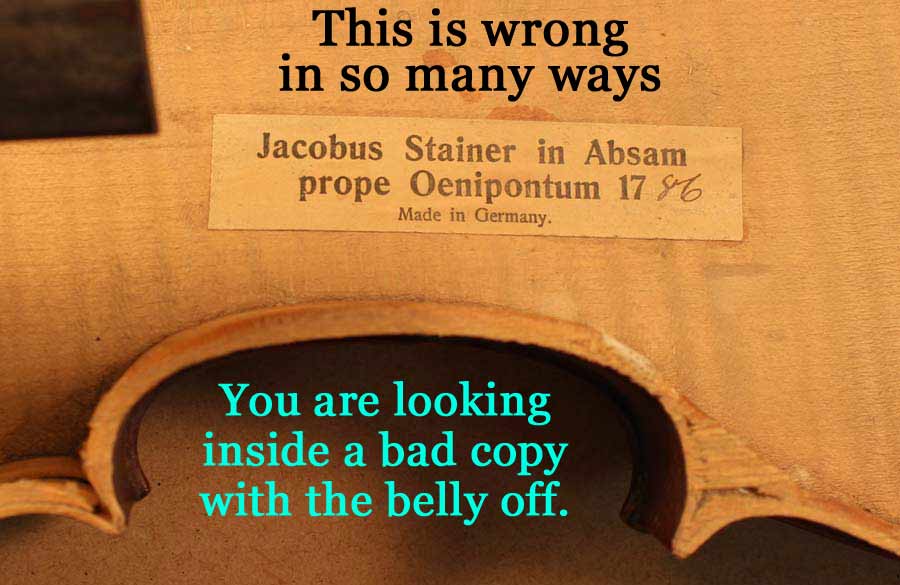
Tip: Most forgeries were made after 1850 and the quickest way to “weed out” forged labels is to look at the paper they were printed on. Original paper from the 1600-1700's was coarsely pressed and darkens with age. It's never smooth and white. Also, the printing will be hand-cut (or cast fonts) which are uneven. If you are unfamiliar with the look of old paper and typeset, visit the archives of any large library. Once you've seen old paper from the proper time period first-hand it's easy to eliminate most forged labels. But still watch out, old paper, type, and even original labels have been used to make “serious” copies and forgeries.
Please realize that prices do vary. Yet I believe the following is a good guideline for 2013.
$34.95 - $150:
New instruments in this price range are almost exclusively from China (not always a bad thing) but it's usually a bad thing in this price range: Green wood, painted fittings, humped fingerboards, thin brittle strings, etc., and consider yourself lucky if you're able to play on all four strings. It usually costs many times the original purchase price to have these instruments “set up” properly and once they are, they're usually miserable to listen to, and expect constant problems. (If you really want to see if “Little Johnny” or “Sweet Suzie” likes playing the violin, don't do it with one of these unless there is absolutely no way that you can afford anything more.)
Used: Sometimes you can find a good deal if you really dig around in the yard sales, pawn shops and craigslist. But don't count on it unless you really know what you're doing.
So, let's get serious... (Each price increase includes all the best features of those of lower price ranges, and will only mention additional or more costly features that come with the higher price tag.)
$150 - $250 (including case and bow) For this price, you should get an instrument that is made to proper dimensions that plays good basic notes, is easy to tune, and has the following features:
Solid ebony fingerboard.
Solid ebony nut.
Solid ebony, boxwood or rosewood pegs that turn smoothly. (Type of wood is a matter of taste.)
Solid tailpiece and chinrest. (Plastic and bakelite chin rests do not “breathe” or absorb moisture, and are famous for creating sores on the neck and chin.)
Varnish will usually be polyurethane (thick, smooth, shiny; almost plastic looking).
“Reasonable” student strings (such as Red Labels), not thin, cheap “factory” strings.
The bridge will be cut to the proper thickness, height, and string spacing, but don't expect too much refinement. (More on this later.)
A bow with real horsehair. Never accept a bow with synthetic hair in this price. Yet, a name-brand fiberglass stick is preferable to a warped or weak wood stick.
A basic case with music pocket and carrying strap.
Watch out for:
Instruments with fat necks and/or not made to the proper length. (Where the nut meets the fingerboard to the edge of the belly should measure approximately 129.5-130.5mm or 5.10-5.14”. Also, from the edge of belly by the neck to the center of the ff hole notches should be approximately 193.5-195mm or 7.62-7.68 when measured with a small flexible tape.)
Do not accept, instruments with no linings and/or no upper or lower corner blocks inside.
Painted purfling.
Plastic 4 tuner tail pieces that are thin and flimsy. (They usually start stripping and falling apart after only a month or two.)
Painted pegs or plastic coated pegs that only look like they're ebony. Look in the drilled holes to make sure they are black inside.
Harsh nasal tones and uneven volume across the strings. (While the sound won't be “wonderful” from this range of instruments it should never be “terrible.”)
A fingerboard that is not properly scooped. Flat or humped fingerboards are not acceptable in this price range.
Spruce on the belly that has knots, is twisted, or the grain is not parallel, from side to side.
Popular upgrades/options:
A nice set of strings. (This is fifty dollars well spent, but make sure the grooves in the nut are smooth and burnished with graphite so you don't break your nicer strings.)
For beginners (especially young children): a name brand 4 tuner tailpiece.
A shoulder rest. (These come in all shapes and sizes: so be choosy.)
A low-priced suspension case. Especially if “Little Johnny” is prone to accidents.
$250 - $500: Expect nicer features, nicer wood, a better “feel,” and a better tone (quality goes up very quickly in this price range.
Expect a well-finished, burnished nut that is flush with the edges of the fingerboard, and a properly “scooped” fingerboard that allows lower string heights and easier playing.
This last point is so important that it must be repeated: A proper fingerboard is never “humped” or even flat; it is scooped. If a straight edge or ruler is placed between the strings it will rest on both ends of the fingerboard and there will be a gap under it: approx .5 mm (.020 inches) under the E string and approximately 1mm (.039 inches) under the G string. Professional setups may vary based upon the strings and aggressiveness of the player, yet they are never very far off. Measuring tools are nice for checking this, but you can also look down a few professional fingerboards and quickly notice that they are not flat or humped, they are “scooped” (slightly offset closer to the nut) to allow the strings to vibrate freely in any position without “buzzing” against the fingerboard.
As the price goes up within this $250-$500 range, expect to see a little “flame” in the maple (those wonderful stripes of color in fine instruments and a nicer cut bridge with a little style. An Aubert Mirecourt, that is well cut and fitted properly to the instrument is a very good indication that you are getting what you are paying for.
Notes about bridges: Cutting bridges is an art, and can affect the tone of an instrument greatly. Watch out for thick bridges used to cover up a harsh metallic sound. (Think about it. When you put a mute on a violin, viola or cello, you're adding weight to the bridge.)
Also, thin bridges that warp easily and don't project well.
The feet should match the belly perfectly; and the top should be tilted back slightly toward the tailpiece (reference video #1).
Also expect higher quality strings (possibly even a nice set of “Dominants”).
This is the transition level between polyurethane and spirit varnish. As you get closer to $500 begin “expecting” spirit varnish.
The package will include a “suspension” case (neck strap, cushions under the upper and lower blocks and a chinrest hold down) and a little nicer bow (brazilwood, a “reasonable” synthetic, or sometimes even a pernambuco, but don't expect too much on any bow included in a standard “package deal”).
$500 - $1,200: (The “better” factory instruments, usually from China, Bulgaria and Germany.)
Features:
Quality spirit varnish (sometimes “toned” to make them look old, yet never cheesy or “cheap”).
A better tone with more volume. (This is mainly what you're paying the extra money for, so shop around until you find what you like.)
Moderately flamed maple. (Deeper flames are better, as a general rule. They look better and usually give a deeper, richer sound.)
Fine-grained spruce (this means that the grains are closer together and the dark winter growth is narrow). This is not a “hard and fast” rule and some of the finest instruments have wide graining, yet unless you know the integrity of the maker and where the wood originally came from, it's a good indicator for this value of instruments.
This price range is usually where an instrument begins “standing on its own” and many of them will not come with any case or bow. If they do, there are no hard and fast rules on what to expect.
This price range also includes many of the older factory instruments from Europe (especially from Germany and Czechoslovakia) beginning around 1870. There are no hard and fast rules for these instruments either, and they range from the worse of the worst to some charming, intriguing instruments, well worth the price. Always get a second opinion when shopping for a used instrument in this range.
Watch out for:
Heavy instruments.
Metallic or muted sounds.
Uneven response or volume across the strings.
On older instruments: shrinkage cracks (especially on the belly by the sides of the neck and saddle) and multiple (and or) bad repairs. (They can plague you for the rest of your life.)
Bad “wolf” notes. When playing in high positions (especially on the G string) some notes can reverberate or “howl”. And while many of the greatest concert instruments have wolf notes, don't put up with them (especially bad ones) unless the payoff is “much more than worth it.”
Special Note: If a violin's label says that it is hand made, it's almost a guarantee that it is not.
$1,200 - $3,000
The best “value for your dollar” in this range of instruments are the fairly old “family” instruments from Germany and Mirecourt and the better, truly hand-made instruments with “reasonably-cured” wood made in China, Bulgaria, etc..
Watch out for:
New instruments from overseas that aren't hand made. (The only way to know is to visit the maker's workshop, or at least see pictures/a virtual tour of their shop with certification papers.)
Also green wood; even on older instruments, this always shows up as cracks in the belly, open/re-glued seams and reset necks. On new instruments, the only thing that you can rely upon is the reputation of the maker. If you happen to live in the same country, visit their work shop and ask to see their wood supply and its age. If there are only a few pieces laying around, be careful. There are hundreds of makers who carve instruments only for a few years; until their instruments begin falling apart. (Not all instruments get better with age.)
Again, unless you have “been around the block” and know what to look for, a second opinion from someone who does, is a must.
$3,000 - $8,000 (the semi-professional instruments)
This is where the prices begin to soar and the water gets muddy, so I'll break the instruments up separately. (Pun intended)
In older instruments, this price range begins purchasing “lesser known names” of individual makers from across Europe.
Again, some of them are wonderful for the price, some of them terrible. Also, unlabeled, unprovenanced (un-documented) instruments that excel in tone. Some have spirit varnishes, and most of the best have oil varnishes (difficult to tell without a lot of experience).
Watch out for: instruments made from outside molds where the ribs come together to form a sharp point and don't overlap, and lack of (or fake) upper corner blocks. (All fine instruments have full blocks and linings and are built around an inside mold. There are, as always, exceptions; yet they are rare.)
Again, get second opinions! Yet, if you're an experienced player with developed tastes and fall in love with a particular sound, and you can afford it. Why not?
New instruments and “kits”: Most living makers, after struggling for a few years carving their own violins, begin purchasing “white” or partially finished violins from overseas, then re graduate the plates (carve the belly and back thinner based upon their experience), then finish them up (sometimes applying their own varnish and putting in their own labels). Some are honest and forthcoming about what they're doing, while others are not. Some of these instruments sound good. Some of them do not. Some are made out of cured wood and will stand the test of time, while most are made from green wood, and will not.
The only way to get your money's worth from these instruments (and it is possible to do so in this price range) is to find out who originally made the instrument, where the wood came from, and how old it is. (You are now paying for an instrument that will stand the test of time. Do everything you can to make sure that it will!) Additional “insurance” comes from seeing and hearing “seasoned” instruments from the same supplier and the same “maker” that are lat least five years old.
Watch out for belly shrinkage cracks, seam separations, and a “pinched” or nasal tone (signs that green wood was used).
This price range also includes truly hand made instruments made from fine, well-cured materials, oil varnishes and the finest setups by “undiscovered” and struggling violin makers from around the world. But also by dishonest makers and dealers who will look you in the eye and tell you exactly what you want to hear not matter how bad the instruments are.
INSTRUMENTS IN THIS PRICE RANGE HAVE ALWAYS BEEN THE VERY BEST, AND THE VERY WORST VALUES FOR YOUR MONEY.
The only way to reduce your risk of being taken, is to do your homework.
Possibly the most important note of all for a future virtuoso looking for a “good deal” is: Joseph Guarneri fell into this price range at the end of his life. And although he died in poverty, his violins are now worth far more than any other maker (including Stradivari).
$8,000-$50,000 The beginning of professional instruments. (Yes, the price goes up exponentially from here)
Mainly old instruments, and the names begin to become familiar (yet don't expect an old “master instrument” from Cremona even if it's been run over by a Mac truck). But if you really shop around, there's wide array of wonderful tones and characters available for the professional player.
There are many symphonies that will not even accept your application unless you are playing upon a violin worth at least $15,000, many much higher, no matter how good you or your instrument may sound.
What to expect from a handmade instrument made by a living maker:
The highest quality fully-cured spruce and maple from the finest forests. This is the single most important ingredient in a fine violin. In this business, take nothing for granted. Ask to see the maker's collection of wood and how it has been stored. Some violins sound quite nice at first, until the wood finishes drying in the instrument.
Expect a fine oil varnish (Though not a “hard and fast” rule in the lower end of this price range). This doesn't necessarily mean a smooth and shiny varnish. In fact, some of the finest instruments have a slightly matte-finish over a textured or freely-carved surface. It's all a matter of taste, if everything is done right.
The finest fittings, strings and setup that allow a professional level of performance on all four strings and in every position.
Most new instruments are made as copies of old masters, yet I strongly suggest going with an original maker who has “refined” their style. For romantics who believe that music is more than just playing notes, remember, “A copy will never have a soul of its own.” Yet, don't shy away from a new instrument just because it does resemble a Stradivari or Guarneri.
Special note as we move on: If you have the means, buy the finest violin you can, regardless of your current perforance level. It is so much easier playing on a fine violin, and you'll enjoy the experience so much better, right from the beginning. But, when you purchase your instrument, make sure that it's a good investment, and always take a professional player or players (as unbiased as you can find, although everyone does has their own particular taste) with you so you can hear it played on in a concert hall, and if they are good enough, they can tell you how well the violin responds to their demands at the highest performance levels.
Make sure the sound will fill the largest concert hall that you will perform in. (There are trade offs between volume and response, but even if you choose the freest responding, sweetest voice, the notes will still “float” to the back of the hall, instead of “dying out” after the first few rows.)
With any professional instrument, always get the audiences opinion. (Many professionals consider their audience's opinion more important than their own.) Then add all of the factors together to make your final decision.
There really can be “magic” in a fine violin (as mentioned in the novel, “Two Trees”) and if you have never experienced it for yourself, keep looking.
Watch out for:
Fake labels and fake claims. Very, very few instruments in this price range have original labels that tell the truth. On the flip side of the coin; there are many Stradivarius violins that will not pass muster compared to some violins in this price range (especially those with massive repairs or that have been pieced together from parts), and they only retain their values as “works of art,” because the Master made them.
While many of the instruments in this price range will last another 500 years if cared for properly, there are others that will be right on the verge of falling apart. (Always have an independent authority go over older instruments, inside and out. You won't be sorry.)
If it's a new violin you're after (especially in the upper end of this price range), make it a point to visit the maker and their shop (multiple times if possible). Realize, that you are buying weeks, if not months of that person's life, and if everything is legitimate, they won't mind spending a few more hours to complete the process. Or, if they do, offer to pay them for their extra time. While you're there, look for yourself and make sure that they actually are the one who made your instrument. This price range is well beyond the level of “kits” and green wood, and at the upper end of this scale you are paying the price of a new “master instrument” (to be compared with all of the instruments listed below) made by “Master Luthiers.” Ask for previous independent appraisals, and have them sign a statement of everyone involved in the making of your instrument. And don't be too surprised, Stradivari had Omobono and Franceso, while some of Joseph Guarneri's finest creations were a joint effort with his father and wife. An honest maker will be pleased that you appreciate the fact that “their work” is original, and everyone involved gets the credit the deserve. A dishonest maker will act offended that you could even question their integrity.
Jacques Francais once taught me: When it comes to a truly fine violin: A true “work of art” is a wise investment, everything else is not.
$50,000-$800,000: This includes; The best of the early Masters, and the remains of, or highly repaired examples of, the later Masters.
Though difficult to imagine, the number of old violins entering the lower and mid-range of this price category is astounding, and no one knows where it will end. They include (but are not limited to) fine old (usually Italian, sometimes French, German, English, etc.) violins made by names that have at least been heard of by most professional musicians.
As the price increases, the names (and usually the quality) improves until true master instruments are reached (though by todays standards, the ones in this price range are not up to the challenge of solo performances in the largest concert halls. Yet, as always, there are exceptions and many professionals have found their “companions for life” within this price range).
What to watch out for:
Forgeries, forgeries, forgeries. Do not purchase an instrument in this price range without two, I repeat TWO INDEPENDANT WRITTEN APPRAISALS (preferably with provenance) including condition (with a comprehensive listing of all repairs and alterations) from qualified, reputable dealers (only those who deal constantly within these price ranges). Added note: There are very few dealers of this caliber in the world, but it is well worth the trip.
Another important note:
There are always TWO values for any violin:
The first one is based upon the violin's beauty, quality of construction, and the music that it will produce.
Second: What the market will bear, based upon the name of the maker, its provenance and all the previous three attributes combined.
In other words, the comparison is: How well the instrument will perform in a blindfold test, verses how much money will it bring at the auction block.
Never forget this.
After playing upon thousands of instruments (hundreds made by Gaspar DaSalo, Paolo Maggini, Jacob Stainer, the Amatis, Antonio Stradivari, and the Guarneri family) I am confident that: The ratio of these two values can be a thousand to one. In other words, I have played upon an $800 “unknown” violin that performed better than most Stradivari's, also upon a Stradivari (one of the finest, most original examples of his work) that sounded “quite awful” no matter how it was adjusted or what strings were placed upon it. Yet, as it was explained to me by Jacques Francais, “And what will happen if you sell that $800 violin for a million dollars, and it loses its voice? What is it worth then? And what will become of your reputation as a dealer? But the Stradivari will always be a Stradivari.
To reiterate: There are two values, and weather you are a professional musician or a collector, you must learn to separate the two before putting your money on the table.
$800,000-$8,000,000: (Master instruments for both the “sophisticated palette” and the virtuoso.)
This range of investment will purchase you almost anything that you desire; from the finest original creations of Jacob Stainer and Nicolo Amati with their “voices of angels” to the “sophistication” and “dominating forces” of Antonio Stradivari and Joseph Guarneri. Or, for the serious collector and connoisseur, the finest representation of music and artistic achievement ever formed by the hands of mankind; from the legends and fantasy of the earliest Masters to the greatest performances in the finest concert halls throughout history.
It's amazing, the amount of prestige and respect gained when you play upon a “Master instrument.” You will always be given the “benefit of the doubt” before your performance begins, and even after a poor audition, your association with these instruments will never hurt your career.
Reminder: Provenance, provenance, provenance. (Certificates of authenticity, list of repairs, and a complete list of known previous owners is a must!).
$8,000,000-$100,000,000: The finest of the fine, “with even more.”
(Regardless of what the record books say, the prices do keep going.)
These are the master instruments that have never seen an auction block. The ones rarely viewed (if ever) by the public, and some of them are not supposed to exist. These instruments usually have standing offers (sometimes for decades and centuries) for amounts many times what might be considered their “fair market value.” Yet, when they become available (usually because of the death of the owner) the prices are paid.
Among these instruments (there are approximately a dozen):
Extremely original, legendary instruments (some still retaining their original necks, cases and bows).
The finest of the inlaid Stradivaris, as well as two of his cellos.
The “Messiah” (as described by Tarisio).
And of course, Paganini's “Cannon” or “Il Cannone” made by Joseph Guarneri, Del Jesu.
What to watch out for: When you have this much money to spend on a fine violin and you're buying it for the right reasons, nothing anyone else could ever say would matter anyway. Just enjoy it.
